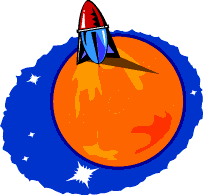

Your Challenge Find a SAFE, Interesting landing Site: Now that you have had time to practice your skills, it's time to get down to business. Remember, in selecting a landing site you have two important considerations, SAFETY and interest. So look for a smooth area near some exciting-looking features! First, download the file Cydonia.map and look at it in NIH Image. This image is a reduced version of Cydonia.1, the image you have been practicing on. A few features are outlined, like a possible old shoreline near the bottom of the image. The "footprint" of the high resolution image that you will use to actually determine a landing site is also shown. Spend a few minutes looking at the region around the landing area to familiarize yourself with the different types of geologic features in the area. Second, download the file Cydonia.2 and save it on your hard drive. This is the important one--the high-resolution landing site image. Open the file in NIH Image and use skills you have learned to clean up and stretch the image. Third, before you start to select a site, compare the detail on geologic features that can be seen in both Cydonia.1 and Cydonia.2. Use the outline of Cydonia.2 on Cydonia.map to help you find the same features on each image. For example, look at the oval-shaped plateau with the conical mountain on top located at X = 298, Y = 546 in Cydonia.1 and at X = 1020, Y = 1040 in Cydonia.2. Both images were taken with the same type of camera, yet in the area of the mountain, the images show a vast difference in visible detail. This difference in visible detail is called resolution, which is a measure of the size of the smallest object that can be seen in an image. The resolution in Cydonia.2 is about 5 times better than the resolution is Cydonia.1, and thus shows more detail. Differences in image resolution can be due to a number of factors. In this case, the spacecraft that took Cydonia.2 was much closer to the ground than the spacecraft that took Cydonia.1. An electronic clearing of the throat gives the signal that SAL is going to get a word in edgewise whether we like it or not: "Remember, the smallest piece of a digital image is a pixel, which is a square with no detail, only a single shade or color. Any object in the image smaller than a pixel simply cannot be seen. So the size of a pixel in an image is a lower limit on the size of any visible object. The resolution of Cydonia.1 is about 4.31 pixels per kilometer, so a single pixel is about 230 yards across. In this image, a football field would not be visible, although a football stadium would just about fill a single pixel. You could see a city block, but not the individual houses on the block. The resolution of Cydonia.2 is about 20.5 pixels per kilometer, so a single pixel is about 50 meters across. In this image you could just barely make out a football field and individual houses--assuming such absurdities existed, of course." Finally, use the Profile tool to find smooth spots near interesting features. Remember, if you think you see evidence of alien artifacts, you had better be ready to defend your evidence. Otherwise, you will find yourself on the next ship back to Earth, where you will be drummed out of the space program and spend the rest of your life on a street corner selling used computer chips.
[ Home ] [ Teacher Pages ] [ Modules & Activities ] |
HTML code by Chris Kreger
Maintained by ETE Team
Last updated November 10, 2004
Some images © 2004 www.clipart.com
Privacy Statement and Copyright © 1997-2004 by Wheeling Jesuit University/NASA-supported Classroom of the Future. All rights reserved.
Center for Educational Technologies, Circuit Board/Apple graphic logo, and COTF Classroom of the Future logo are registered trademarks of Wheeling Jesuit University.